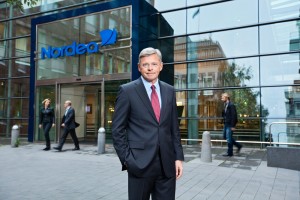Nordea, SEB resilient against headwinds, differ on pay-out
Jan 30th, 2015
Nordea and SEB opened the latest earnings season this week with results that were resilient against the headwinds from autumn interest rate cuts and bode well for their peers, although the dividend and capital policies of the two Swedish banks contrasted.
 Their figures kicked off reporting for Nordic financial institutions, with Nordea first, on Wednesday, and SEB on Thursday. Swedbank reports next Tuesday, Svenska Handelsbanken on Wednesday and SBAB on Friday, and they are joined by leading Danish, Finnish and Norwegian banks.
Their figures kicked off reporting for Nordic financial institutions, with Nordea first, on Wednesday, and SEB on Thursday. Swedbank reports next Tuesday, Svenska Handelsbanken on Wednesday and SBAB on Friday, and they are joined by leading Danish, Finnish and Norwegian banks.
Nordea reported a pre-tax profit of Eu1.16bn, up from Eu1bn a year earlier and marginally below consensus forecasts.
“We are in 2014 delivering a robust result with stable revenues, decreased costs and improved credit quality leading to a 9% increase in operating profit,” said Christian Clausen, Nordea CEO (pictured). “This is despite a challenging environment with low growth, low rates and increased geopolitical tensions.”
SEB’s pre-tax profit came in at Skr6.6bn (Eu710m), up from Skr5bn in the same period of 2014, but 3% below expectations.
Mats Anderson, equity research analyst at Kepler Cheuvreux, said that although the two banks’ revenues were weak — net interest income for both came in 3% below expectations, at Eu1.36bn for Nordea and Skr5.01bn for SEB — this reflected the low and falling rate environment. Meanwhile, there was good news on commission generation, he noted, with Nordea’s, at Eu763m, 5% ahead of expectations, and SEB’s, at Skr4.55bn, 11% ahead, on the back of greater capital markets and corporate activity.
And he said that it was positive to see that credit quality remained high in the quarter, while both banks had shown good cost control.
“Although we have all these troubling signs — with Russia, oil, etc — the provisioning has been kept at low levels,” said Anderson. “There has been a certain increase in problem loans, but it is nothing to write home about.”
On the back of its improved profits, Nordea increased its dividend to Eu0.62 per share, up from Eu0.43 — equivalent to an improvement in the pay-out ratio from 56% to 73% — and the bank said that it hopes to increase this further in 2015 while maintaining a strong capital base.
“This is an aggressive message from Nordea,” said Anderson. “What we are seeing is it coming into the same camp that Handelsbanken last year joined Swedbank in.”
Announcing its intentions regarding the pay-out ratio, Nordea noted that it is maintaining a strong capital base. Its Common Equity Tier 1 (CET1) capital ratio was up 1.8% to 15.7% at the end of 2014 and Nordea said that it aims to operate with a CET1 ratio of approximately 15% including a management buffer, versus a regulatory requirement of 14.8%.
SEB increased its dividend to Skr4.75 for 2014 from Skr4 a year earlier, representing a fall in its pay-out ratio from 59% to 54%, although Anderson noted that SEB’s figure excludes capital gains and that including these gives a pay-out ratio of 65%. The bank maintained its stated distribution policy of a pay-out ratio of 40% or more.
SEB meanwhile reported a CET1 ratio of 16.3%, up from 15% a year earlier, and communicated that it will run a management buffer of around 150bp against a regulatory requirement of 15.6%.
Anderson contrasted the two banks’ approaches.
“The management buffer Nordea feel they need to have above the regulatory minimum requirement is apparently just 20bp-30bp,” he said. “In SEB’s case, there is of course a different business and geographical mix, but the fact that they are going on such different paths is something of a mystery.”








